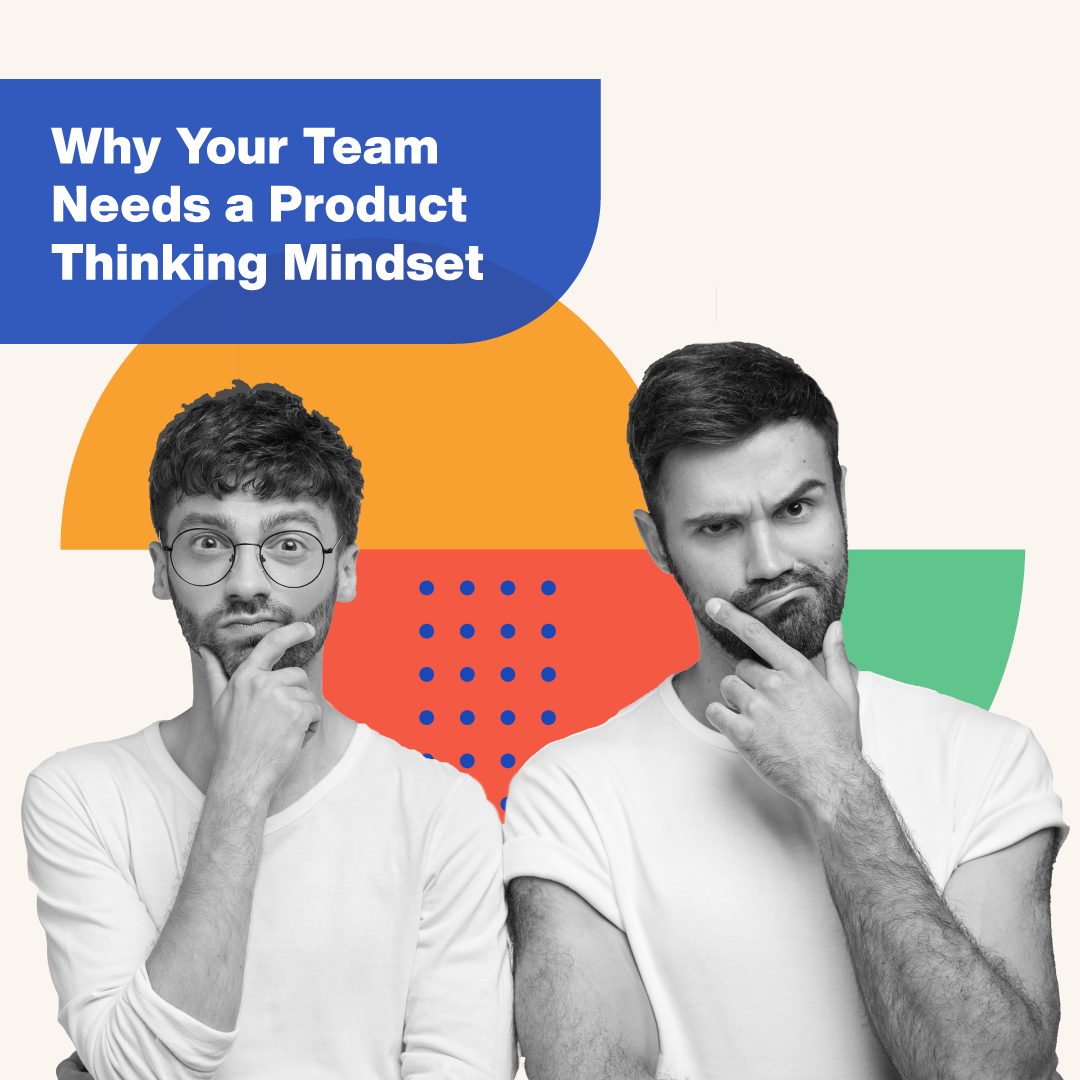Product thinking is a culture of customer experience that motivates every decision and gets teams to focus on the whole user experience. We explore what you can do to move your (non-product) team into a product thinking mindset – and why this matters.
In today’s market, every company is a technology company, regardless of the product or service it provides. The companies that transform themselves to compete and win in the digital economy have a specific mindset that borrows from excellent product management teams.
Most companies aren’t yet ready to compete effectively in the digitally savvy, pandemic business era. For some, it’s a shortage of talent and the right skillsets; for others, it’s a working environment bogged down with clunky business processes; for others (the majority), it’s a skills gap cutting through critical parts of the business.
Underlying most organisational effectiveness issues is mindset: our old ways of doing things and thinking about what value we add don’t work anymore in the new world. Below we explore what you can do to move your (non-product) team into a product thinking mindset – and why this matters.
What is a ‘product mindset’?
A mindset is a way of thinking or a set of approaches that informs how we achieve our goals. A product thinking mindset is not a phase or step at a single point in a system or at one level of an organisation – it’s a way of approaching things across the whole ecosystem.
In today’s world, companies are held to much higher standards. Their digital presence, brand, and customer service are judged not by the annual board report but by millions of online customers (who don’t tend to hold their opinions on social media!).
Product thinking allows us to deliver ongoing, meaningful value by approaching our product or service as something that evolves and improves. We base our decisions for this on robust customer data. If you want an organisation that meets your customers’ approval, you need to move out of thinking in a static, fixed way into one that prioritises organisational agility.
The value of product thinking
Product thinking is a culture of customer experience that motivates every decision and gets teams to focus on the whole user experience. It’s more than a working framework; it’s a mindset, a customer experience culture and ultimately a competitive advantage for the whole business if done well.
Building solid and user-centric products and services come down to a few factors: a spot-on understanding of your customer, their problem and your solution to it. Teams who do this well have learned to place the customer and their feedback at the heart of what they do and take an iterative approach to idea generation. The people who are already good at this? Product teams.
From output to impact
Product thinking helps teams move away from broad market targeting to what the new world requires: segment-specific targeting. This is about applying product thinking to every project, initiative, and policy we create.
We move away from a deliverables-based mindset and closer to the agile, customer-centric view that sets great companies apart. Product thinking lets your teams solve for need (they are driven by fast, flexible, focused customer research) and excel at change (they know when to change course, stick to the journey or let go).
A product-centric delivery model demands focus on the eventual goals of an organisation rather than short-term achievements. Because of the jargon, organisational hierarchies and old siloed ways of doing things, we tend to think of product managers as the ones who ‘do product’. But, actually, everyone in an organisation co-creates products and services for a customer base, no matter how far removed you are from face-to-face contact.
As HBR aptly put it: “…this begins by rethinking the initiative not as a set of boxes to tick but rather as a problem to solve for a specific set of customers. The measure of success …is not the deployment of a product but a measurable positive change in the behaviour of those customers. In other words, we’re working towards outcomes, not outputs.“
Taking a product approach to your customer
Product thinking aids in building this empathy for users and emphasises the importance of delivering value owned and understood by the entire team. This gives the team a sense of purpose and insight into how their efforts directly impact the things they produce.
A great leader in today’s world focuses less on tick boxes and fixed ways of achieving goals and more on continuous service and product improvement. They observe and measure their customer behaviour and make data-based decisions on whether to continue improving something or allocate resources and teams to something else. This approach is as relevant to the customer excellence a fruit seller provides on the street as it is to the designer creating new app features for a tech startup.
What do product teams do well that you can use in your non-product team?
Good product-led companies tend to do three things well:
- They develop the right strategy to win their target market.
- They fine-tune their business model to capture this market.
- They keep adapting to keep pace with changes in consumer behaviour and needs.
Building strong, user-centric products and services comes down to a few factors: a spot-on understanding of your customer, their problem and how you will solve it. Teams who do this well have learned to place the customer and their feedback at the heart of what they do and take an iterative approach to idea generation.
In addition, they are driven by a relentless desire to explore, discuss and learn from mistakes, not by performance goals which become punitive when things ‘go wrong. It’s one thing to talk about making mistakes; it’s another thing to take a detached and positive approach to why they occur.
Teams that own an experience or outcome end-to-end can move quickly because they can make most decisions independently and can coordinate directly with any other teams involved. For example, let’s say a social housing company has a team of data analysts and customer research staff. Suppose they never interact or work in the shoes of the customer services department ever. In that case, they won’t see if the valuable data they’re sharing is actually changing on-the-ground operations of how customers are being dealt with daily. And suppose the company leaders don’t have an organisational goal of excellent, customer-centric service. In that case, one or both of these departments will work without much direction or motivation to improve.
Mindset over methodology
Many companies tend to over-focus on product management methodologies because they like the sound of how productive an approach is. For example, Agile is a flexible project management method with a speedy, iterative approach to product development. However, if you’re building the wrong thing, you will not go far.
Agile is a method for solving the problem in the most efficient way possible. Product thinking looks at drivers and the competitive landscape. It helps you determine the actual problem the user is facing.
Product thinking holds teams accountable for justifying what their actions and outcomes of these will be. This is more time on the ‘boring’ side, such as problem and competitor research, user research at scale and depth, and constant iteration of the same idea until it’s proven a product-market fit. Your entrepreneurial leader or innovative CEO may like this part of the process less than the ideation part. However, if you can bring a quality solution or service to market, your foundation work is justified.
Developing a product mindset in your non-product team
The point of product thinking is to make sure we’re focusing on the full user experience – whether that’s an internal department, the work of a marketing squad or a customer service department.
Every team member can develop product thinking skills. So, where do you start?
Begin with the customer
Your team needs to be genuinely interested in what would improve the customer experience before you can get them aligned and willing to pursue a shared goal. Get them excited about a new approach by pitching teams and places where it’s worked brilliantly. Share inspiring examples to motivate your team to learn this new way of doing things.
Identify the problems you want to solve
Knowing the company’s big-picture strategy and lessons learned from past mistakes helps people be more effective in their roles. When people have a say in what problem they’re going to solve and how they’re going to solve it, they are naturally more excited. They feel heard and included.
In a product-led company, the company goals are your starting point for product goals. Make sure you know what problems you want to solve, and then start to identify small actions to make progress. For example, a team challenge could be “our decisions are not supported by data, so we don’t know if they positively affect our service offer”. Understand the problem your customer needs to solve, which should ultimately align with your company’s goals and your own team’s business objectives.
Start small
Becoming product-led is an ongoing process. It takes a continued team effort. Begin by encouraging and practising inquiry in your team, like asking ‘why’ in group discussions to understand how product decisions are being made. If you start small, you can bring a thinking shift to a small and agile setting before taking it wider. It can also encourage product-thinking champions in your team who can help you introduce this mindset to others.
Give your team clear KPIs and OKRs
Good product management begins with tracking suitable usage KPIs (not self-validating metrics) and building feedback loops so that you can hear what the market is telling you about your product. Little customer actions should feed into your decision-making processes: are we on the right path to deliver the value our customers want?
Setting clear goals and metrics to measure success is key to thinking about outcomes. Each team and organisation should have their own goals and user problems to solve, which are specific to them. It’s not enough for them to document their ideas – you need to work with them to make sure they these into ones which align to the heart of what you’re trying to achieve business-wide.
Get buy-in from key stakeholders, including leadership
Your team’s work will only go so far if the messages and programmes coming from the top don’t align at all with a product thinking approach. Show (versus tell) your colleagues how your approach can benefit them and the whole business by sharing some of the experiments your teams have run. Look for opportunities to demonstrate product thinking at a small scale.
Organise your team effectively
When people have an ownership mindset, they take responsibility for outcomes – not just output – and are empowered to make the decisions that will lead to those outcomes. Product-centred teams are self-organising and purpose-driven; they can quickly start, stop or pivot when facing hurdles. But, most importantly, they are empowered to solve problems together and effectively, using a shared process.
Organise your team in a way that works for your business outcomes. Look at what other companies are doing to help inform your approach, like Spotify or Hubspot. Try things out with your team and see what sticks. The trick is making sure end-to-end ownership doesn’t result in siloed teams, where staff don’t see the impact of their work because they don’t sit in a different section of the organisation.
“A product shift typically requires organisations to rewire from top to bottom and reimagine how work gets done and delivered. It’s a step-by-step journey toward a customer-focused mindset, which can enable and empower teams beyond IT to deliver iterative value, reaching every corner of the enterprise.”
– Deloitte, 2021
The companies that transform themselves to compete and win in the digital economy have a specific way of thinking about organising their teams and empowering them. Product thinking gives every team the big picture of why your function, team or company exists in the first place. It’s the common purpose behind all of your combined actions as an organisation and why you’re doing your work. Anyone building a product or offering a service can benefit from product thinking and its tools and practices – a mindset shift is the first and most important step you can take.






